Plain and simple, crappie are meat eaters. They love bait. And the like their bait live. There are several fishing rigs that are ideal for catching black and white crappie. They can be rigged with bait, lures or jigs, but you’ll always get the best result when you use a well designed rig baited with a live minnow.
Presenting your bait in the right way can be challenging, given that crappie can be found in a wide variety of habitats and water conditions. Selecting the right rig for your specific location can make the difference between catching a boatload of crappie and getting skunked. Whether you like trolling deep water or casting using rig designed for crappie fishing will keep the fish biting.
The following are some traditional rigs and setups that will help you maximize your crappie catch.
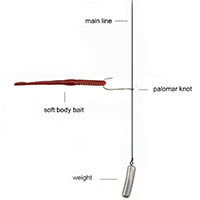
A bass fishing rig that can be fished deep, shallow, and anywhere in between
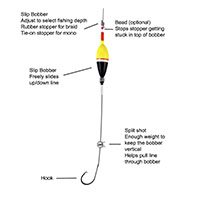
Offers the ability to adjust how deep or shallow by adjusting the bobber stop
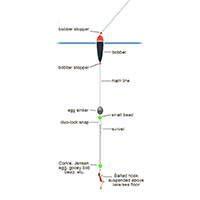
One of the most traditional and effective rigs for catching a large variety of fish
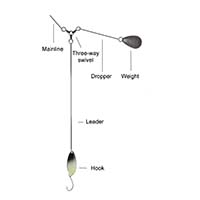
A versatile rig for fishing natural or artificial bait from shallow to deep water
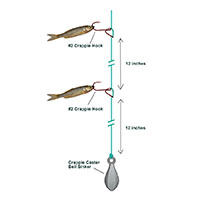
Popular minnow rig using bobber and sinker to attached and hook crappie
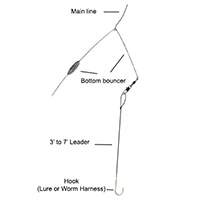
Trolling rig that keeps bait close to the bottom while minimizing snags from cover
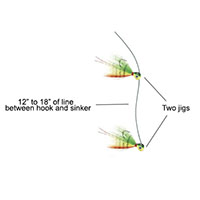
Popular panfish rig used for spider rigging, drift fishing and casting from a boat
Drop Shot Crappie Rig
Drop shot rigs are primarily known for bass, but they can be just as effective for catching crappie. Drop shots excel when water temperatures are cold and crappie are a bit lethargic. This is when the drop shot rig really shines!
For the drop shot crappie rig all you need is a hook and bait with a bell sinker or split shot to take your line down. Thread your line through the eye of the hook leaving about 6-7 inches of tag line. Tie the hook to the line using a palomar knot. Feed the line back through the eye of the hook and tighten to allow the hook to stand straight out from the line.
Tie a loop in the end of the tag line. Attached your split shot or bell sinker to the loop. Again, either a slip shot weight or bell sinker will do the trick. However, if you go with a bell sinker, make sure it’s small. Anglers will often use a split shot instead of a bell sinker is because the split shot is smaller and lighter. A lighter weight makes the rig easy to control and tends to behave more naturally.
Insert your minnow or soft plastic on the hook. Crappie love live minnows, but a minnow imitation, such as a berkley gulp minnow, works fabulously for catching crappie. When casting, allow the rig to fall to the bottom. Crappie will often strike as the rig falls through the water. After you hit bottom, take up the slack, secure your line and jiggle your rod tip up and down—and work it.
Slip Float Rig
Slip bobber rig or slip cork rig, it goes by many names but is most commonly known as a slip float rig—and it’s a tremendous crappie catching tool. If you’ve never fished crappie with a slip float, you should really give it try.
There are few configurations for this rig, but a simple slip float rig is just a float that is designed to slide up and down the line with an adjustable “bobber stop” to allow you to control the depth of your bait. Most have a hole running through the middle that accomodates the line.
The best slip foat setup for crappie includes a bobber between 1 1/2 and 3 inches in length and a 1/24 to 3/16 ounce slip weight. Your bobber stopper should be small enough to slide through the eyes on your rod but sufficiently big to prevent your float from moving farther up the line than desired.
To set the depth of your bait, simply move your stopper up the line to the desired distance from the bait. For example, if you want your bait suspending 4 feet below the surface, adjust your stopper to 4 feet from the bait. It’s that simple.
For setting the bobber stop for a specific depth, most anglers will just “eyeball” it. However, using your rod as a makeshift measuring tape provides a little more accuracy. If you have an 8 foot rod, and want to suspend your bait 6 feet down, holding your hook at the butt end of your rod, move the bobber stopper up the line until its about 2 feet from your rod tip.
Float Rig
The float rig is one of the most traditional and simple rigs for catching crappie. If you want a rig that is no frills but will get the job done, a float rig fits the build.
The float rig is almost identical to the slip float rig—minus the “slipping” part of the equation. Where the depth of your bait on a slip float rig is adjustable by moving a stopper up or down the line, with a traditional float rig, the bobber stop does not move up or down the line and the bobber remains as a fixed distance from the bait.
Anglers like traditional float rigs because they’re simple and reliable. They don’t have any moving parts and are liable to come loose or break. If you know the depth where fish are suspending, then a simple float rig will reel in crappie all day long.
Three-Way Swivel Rig
The three-way swivel is a simple and effective rig that comes in a large variety of configurations. It can be used in cast and retrieve, for fishing current, and most importantly trolling—and it can be fished shallow or deep. Its versatility makes it an attractive setup, but it’s really the go-to rig for anglers targeting crappie slow trolling.
It can be configured to fish a single bait, or several baits. It even has the ability to fish multiple baits at different levels in the water column. You can configure the rig with lives minnows, minnow imitations, and jig-and-minnow combinations. There are literally unlimited options for configuring and fishing a three-way swivel rig when targeting crappie.
Crappie Minnow Rig
Crappie love minnows, and any presentation that incorporates minnows in a natural way is going to get bites. That is how the crappie minnow rig came about. The crappie minnow rig can be setup using live, dead or imitation minnows—but is most effective with live minnows.
There are a few configuration options for this rig but the most straight forward and popular includes a bell sinker to secure the rig to the bottom and two crappie hooks attached to the main line about 12 inches up from the sinker and 12 inches apart. This configuration can be still fished, or cast and retrieved along the bottom.
Other common configurations include a bobber with a single hook at the tag end with a split shot weight midway up the line, a stump-bumping option where a hook is afixed to a sinker weight, and a vertical jig setup with two hooks and no weight.
Bottom Bouncer Rig
The bottom bouncer rig used primarily whe trolling for walleye, but it also makes an excellent rig for drifting or trolling for crappie. Set it up with a nightcrawler, minnow or rapala, give it a little motion, and you’ll start getting crappie bites if they’re to be had.
The rig consists of a L-shaped wire with an oval weight affixed to the long arm. A 3′-7′ leader with spinner rig, worm harness, or live bait rig is attached to the shorter (non-weighted) arm of the wire. Trolling the rig at about 1-1.5 mph the weight arm will bounce along the bottom as the shorter arm—with the baited leader line—swims about 8-12″ off the bottom.
The key to trolling the bottom bouncer rig is to fish it with your line at a 45 degree angle from the bottom. To achieve this, lower your rig straight down through the water column until it settles on the bottom. Take up any slack in the line and then secure the line. Put your boat in motion and let out the line again until the rig hits the bottom again. Now click the reel over and place your rod in the rod holder. You’re line will be at about a 45 degree angle from the bottom at trolling speed of about 1.5 miles per hour.
Double Jig Rig
The double jig rig is simple no-frills rig, but it gets bites. It’s ideal for presenting two different lure styles or colors at the same time at different depths in the water column. Simply tie two crappie jigs about 12 to 18 inches apart to the same line, one at the tag end of the line and the other 12-18″ above it—no weight required.
If weather and water conditions call for a 1/16-ounce weight presentation, then just make sure you use two 1/32-ounce jigheads to get your rig behaving correctly. If you need a slightly heavier presentation, then adjust the weight of your jigheads up accordingly.
Most anglers will use equal size double jigs, but lure designer George Toalson suggests using a slightly lighter jig on the bottom gets more bites. For this configuration, try using a 1/16-ounce jighead on top and a 1/32-ounce jighead on the bottom.



